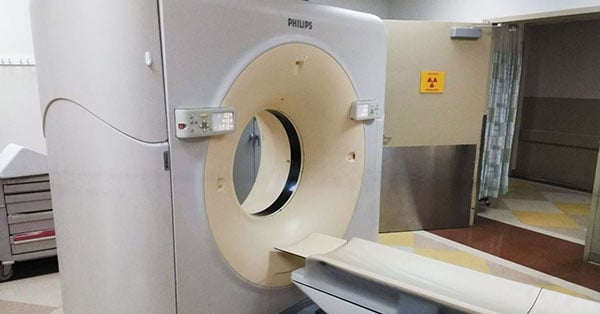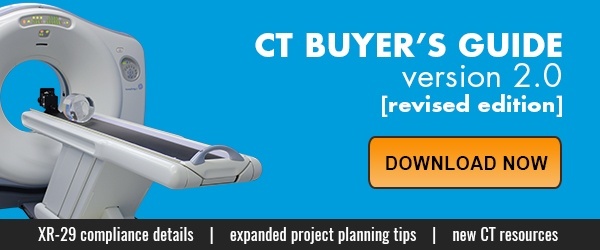
When discussing 16-slice Philips CT scanners, the first distinction that must be made is which version we're talking about: the MX8000 IDT 16 or the Philips Brilliance 16. I’ll try to demystify the difference between them and help you determine which one is best for your needs (or maybe even help identify which one you already own).
The main reason for the confusion is simply that there are two names for four types of systems. Knowing which one you're looking at can be important, as there are pretty dramatic differences in their features and prices.
Philips 16-Slice CT Comparison
MX8000 IDT 16 with Old Style Gantry
The first type we'll discuss is the MX8000 IDT 16, with the older style gantry (the V design). Most of these scanners were manufactured through the end of 2003. The design is the same gantry that was used all the way back to the MX8000 dual slice scanner, as early as 1998. These scanners are water-cooled and have the Dura Akron Q tube (5.3 mhu). If a system with this gantry says “Brilliance” on it this only denotes that it has Brilliance software features, not Brilliance hardware.
MX8000 IDT 16 that LOOKS Like a Brilliance
The second type of 16-slice Philips CT is still an MX8000 IDT 16, but it looks like the newer Brilliance scanner with boxier covers and the yellow coloring inside the bore. Sometimes this scanner will actually say “Brilliance” on it, which is confusing, but nearly all of the parts are interchangeable with the MX8000 IDT 16 described above. These are always water-cooled and always have the Akron Q tube (5.3 mhu). Nearly 100% of this version were manufactured in 2004 - a "transition year" to the true Brilliance scanners we’ll discuss next.
Secret tip: if you still can’t tell which Philips 16 slice scanner you are looking at, investigate the serial number. If it starts with a 3 (four digits) it is the water-cooled version.
True Philips Brilliance 16- "Big Tube"
The third type is one of two 16-slice scanners that are from the Brilliance series in both their original software and hardware features.
A true Brilliance 16-slice "Big Tube" CT scanner:
- has box style covers with a yellow bore
- has completely different hardware than the MX8000 IDT 16
- has an MRC 600 CT tube (8.0 mhu)
- is air-cooled
Beyond just the covers, it is a completely different system from the MX8000. This style of Philips CT was not installed until 2005 and much of the same platform and technology are still being used on Philips' 64-slice scanners.
True Philips Brilliance 16- "Small Tube"
Like its big tube counterpart, the other type of Brilliance 16 also:
- has box style covers with a yellow bore
- has completely different hardware than the MX8000 IDT 16
- is air-cooled
The differences, however, include:
- manufacturing dates in 2006 and after
- a lower-capacity 5.0 MHU, CRT 2150 tube made by Dunlee
- a smaller 48 kW generator
Secret tip:. if you still can’t tell, investigate the serial number. If it starts with a 5 (four digits) it is an air-cooled, factory-born Brilliance. To tell which of the two Brilliance scanners you have, look for a Dunlee logo on the tube.
Deciding Which 16 Slice Philips CT is Right For You
Consider that a true Brilliance won’t require a chiller, so it has one less item to purchase, maintain, and find space for. However, the tubes are about twice the cost and the other parts can be more expensive too. This means that service costs will be higher than those of either MX8000 variety.
The true Brilliance is newer, so the initial purchase price will typically be higher, but it also has newer technology that may allow for higher patient throughput. Newer technology also increases the likelihood that, for US users, a given system will be compliant with NEMA standard XR-29.
Ultimately, the Philips MX8000 IDT 16-slice will be less expensive to purchase and service than a Brilliance 16, but a chiller will be needed. Generally speaking, the IDT series will be the lowest cost option for a 16-slice CT but, as they say, “It’s not about the money... it’s about the amount.”
For more information or to inquire about system availability please contact us!

Paul Crawford
Paul Crawford is the Vice President of Equipment Solutions at Block Imaging. Paul connects with healthcare facilities across the world to offer CT solutions and manages the wholesale sales team. When Paul is not helping customers with their CT needs, he enjoys spending time with his family, watching MSU sports, and CrossFit.






